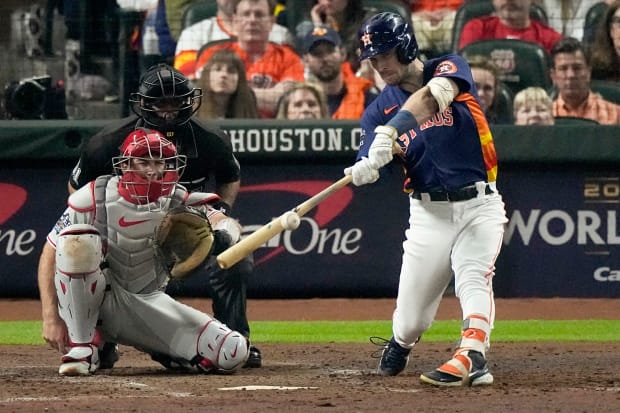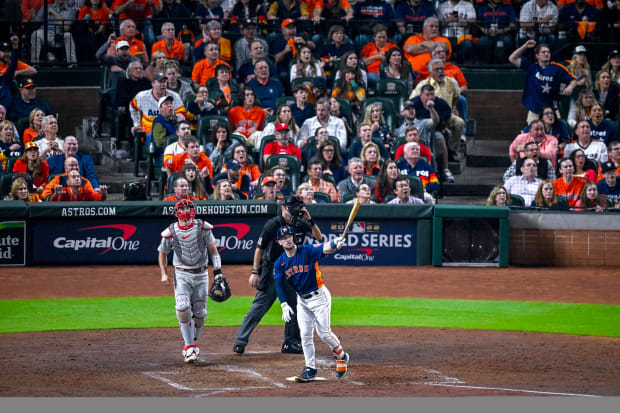Just before his highest moment, Alex Bregman stared at his lowest body part. His left foot—his front foot when he hits—had been betraying him for something like two years, and just as he had started to figure out how to put it where he wanted to, he lost it again.
After his second at bat of Saturday’s Game 2 of the World Series, which his Astros would win 5–2 over the Phillies to even the series, he returned to the dugout looking disgruntled. He had put good swings on the ball in both at bats, but his back hip was drifting backward and leaking forward, which slid that left foot a few inches behind where he wanted it to go. The result was a pair of grounders to shortstop.
“I’m flying open,” the third baseman lamented to hitting coach Troy Snitker.

Sue Ogrocki/AP
Snitker had heard this before. He’d also said it before. Almost since he arrived in Houston in 2019, Snitker had been gently suggesting to Bregman that he consider focusing on his lower half. He’d been mentioning this “for a while,” he says, smiling. “Forever,” Bregman says.
But at this moment, with the Astros up 3–0 a night after allowing a 5–0 lead to evaporate, neither man was thinking about the nights they spent dissecting video or the emotional conversation they shared in the batting cage one afternoon or even the time, on the eve of the season, when Bregman admitted he was afraid to play baseball. They were thinking about that foot.
After it was over; after Bregman had stridden to the plate in the fifth inning, taken two Zack Wheeler sinkers inside and deposited a slider in the seats above the Phillies’ bullpen; after he had hit his 15th postseason home run, tying him with Babe Ruth; after he had called this stretch “the most fun I ever had playing baseball”; he would credit Snitker for finding the key that unlocked that swing.
During the American League Championship Series, they had settled on a new swing thought—”stay tall, land closed”—that seemed to work, but that was no longer enough. Toward the end of that series, Bregman felt himself begin to struggle again, and in Game 1 of the World Series, he says, “I was late because I was thinking about it too much in the box.”
He still needed to stay tall and land closed, but as he and Snitker watched video on the iPad in the dugout, Snitker suggested another term: “Keep your back hip over your back foot.”
“So the next one,” Bregman says, “I thought about keeping my back hip over my back foot.”
Most hitting coaches like to say that hitting is about timing. Usually they mean that each stage of a batter’s swing must work in concert with the ones before and after it. That’s not what Snitker means.
“A lot of things in hitting are timing-related,” he says. “Sometimes you may not be in a place to make adjustments at that time. Sometimes you have to get to the point where it’s like, Man, I really need to assess what I’m doing and really dig in and some of the other things I’m doing aren’t working, so I do need to change my thought process.”
For Bregman, 28, that point came this summer, somewhere around when his OPS dipped to .694, the first time it had dived so low so late in a season since his rookie year. His sophomore year at LSU and that rookie August had been hard. But nothing had been quite like this.
He could see the problem. He could not see the solution, in part because he had never needed one before. From 2017 through ’19, he was worth 19.3 wins above replacement at the plate, behind only Angels center fielder Mike Trout and Brewers outfielder Christian Yelich, and he did it by just deciding not to fly open. But now that wasn’t working.
“I always used to think just stay closed and I never had to actually work on different ways of doing that,” he says. “So for two years, I’m thinking, stay closed, stay closed, stay closed, and it’s not working, and I’m just like, I know what I’m doing wrong and I do not know how to fix it. I used to be able to fix this from pitch one to pitch two in an at bat. I’d feel myself come off a ball and then I’d be able to stay on it the next pitch, like that.”
He did not yet see what Snitker saw: Bregman’s legs no longer worked as well as they once had. He had missed three weeks in 2020 with a strained right hamstring and more than two months in ’21 with a strained left quad, and although he was finally healthy entering this season, he could not shake the memory of hurting himself. As the ’22 season approached, he called Yelich, with whom he played on Team USA in the ’17 World Baseball Classic and who works with Alex Guerrero, Tom Brady’s trainer.
“Bro, he’s the man,” Yelich told Bregman.
The night before Opening Day, Bregman confessed to Guerrero, “I’m scared to play.”

Jerome Miron/USA TODAY Sports
Together they developed a program of deep- and light-tissue work that he could do before and after games, and Guerrero helped him improve his hydration. But the most important instruction Guerrero gave him was: “As soon as you hit the field, I want you going as fast as you can go, full speed, no matter what.”
Bregman says, “I literally just said, ‘If I’m gonna blow out, I’m gonna blow out right now.’ I just had to get over the mental block. Physically, my soft tissue is in the best shape it’s been in since probably ’20. I just had to believe that.”
In some ways, that made his struggles at the plate even more frustrating. He felt great. Why was he rolling over everything?
Snitker says, “I don’t think it was so much stubbornness.” Bregman does. “I was pretty stubborn,” he says. “Like, No, I’ve thought this way forever. I know that all I have to do is think this and I’ll do it.”
Snitker was sympathetic to Bregman’s position. “He got to an extremely high level a certain way,” Snitker says. “It’s hard to deviate from that. He got MVP votes in multiple years. Obviously there wasn’t anything broken at that point.” And Bregman is among the best in the game at finding a way to compete even when his mechanics are off, so he continued to believe he would break through.
Instead he just continued to break his own heart. Snitker began to worry about how worn-down his normally bubbly third baseman looked. Finally, shortly before the All-Star Break, during a pregame session in the Minute Maid Park batting cage, Snitker gave Bregman the hard sell: Hey, bro, this is what you’re doing. I don’t care if you tell me no. This is how it works sometimes. You can’t think about what you thought about the year before.
“I think it was kind of an uncharted place,” Snitker says of that moment. “It could go either way.”
But Bregman was desperate to fix himself, and the message finally got through. They watched video of Bregman’s at bats early in his career, and Snitker pointed out the way his lower half provided the foundation for his bat path. “You were doing these things,” he said. “You didn’t know you were doing them.” (“That’s great when it’s going well,” Snitker says now. “It’s the best thing when it’s going well. It can be the worst thing when it’s not, because it’s tougher to get guys back on track.”) They tried a few new drills. Bregman adjusted his swing thoughts. He felt a change almost immediately.
“A lot of the other things you were worried about are taking care of themselves now,” Snitker pointed out. “We’re thinking about one or two things and getting six things.”
A few days later, Bregman went 3-for-5 with a double and a home run against the Royals. He cites that game as the moment he knew he would emerge from the hole he spent two years digging. He still watches video of those at bats when he feels himself start to regress, which is not often: From July on, Bregman had an .864 OPS.
“I’ve never had to think about lower body in my swing in my life until this year,” he says. “This is the first time I’ve ever thought about lower body in my swing at all. I’ve always just thought, Hands, hands, hands, hands, hands, that’s it, and the lower body was just there. So I started thinking about lower body.”
He and Snitker still do those drills every day. One involves hitting with a resistance band wrapped around Bregman’s knees to keep the spacing between them consistent; another has Snitker pitching to him from behind him, essentially from the shortstop angle, which makes his mistakes look especially terrible. He thinks about what they call scissoring—almost dragging his back foot backward to emphasize the direction. “It feels so weird,” he says. “But now it’s feeling normal.”
His performance is starting to look normal, as well. Through the Astros’ first nine playoff games—eight of them wins—his OPS is .998. So he was frustrated when those first two at bats in Game 2 felt more like June than October. But in June, he thought, Hands, hands, hands, hands, hands, and he wondered why his front foot ended up in the wrong place. In October, he kept his back hip over his back foot and he stayed tall and he scissored his back foot.
His front foot landed where he wanted it to. The ball did, too.







